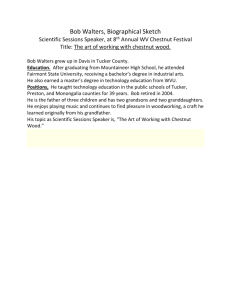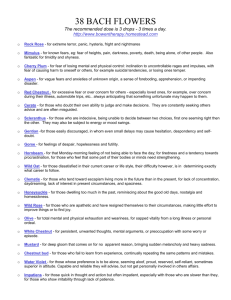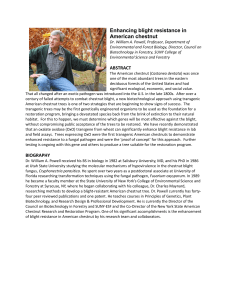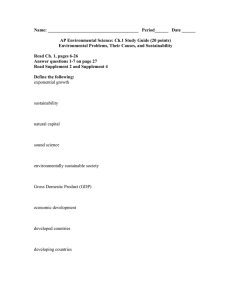Will Biotech help Bring Back the American chestnut?
advertisement
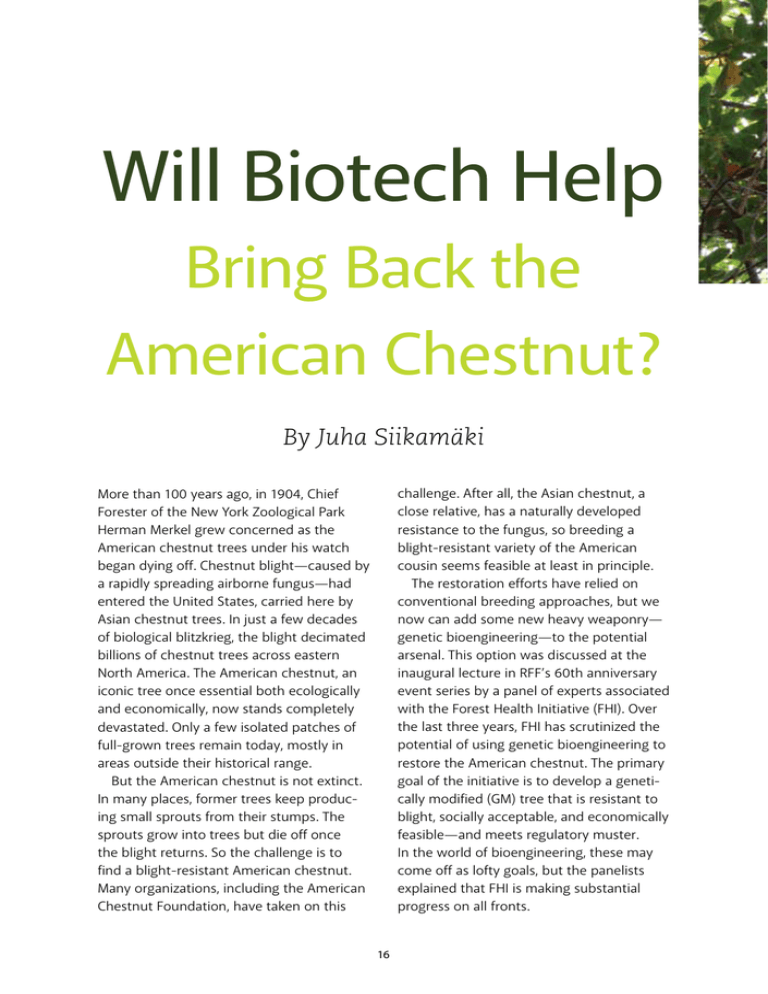
Will Biotech Help Bring Back the American Chestnut? By Juha Siikamäki challenge. After all, the Asian chestnut, a close relative, has a naturally developed resistance to the fungus, so breeding a blight-resistant variety of the American cousin seems feasible at least in principle. The restoration efforts have relied on conventional breeding approaches, but we now can add some new heavy weaponry— genetic bioengineering—to the potential arsenal. This option was discussed at the inaugural lecture in RFF’s 60th anniversary event series by a panel of experts associated with the Forest Health Initiative (FHI). Over the last three years, FHI has scrutinized the potential of using genetic bioengineering to restore the American chestnut. The primary goal of the initiative is to develop a genetically modified (GM) tree that is resistant to blight, socially acceptable, and economically feasible—and meets regulatory muster. In the world of bioengineering, these may come off as lofty goals, but the panelists explained that FHI is making substantial progress on all fronts. More than 100 years ago, in 1904, Chief Forester of the New York Zoological Park Herman Merkel grew concerned as the American chestnut trees under his watch began dying off. Chestnut blight—caused by a rapidly spreading airborne fungus—had entered the United States, carried here by Asian chestnut trees. In just a few decades of biological blitzkrieg, the blight decimated billions of chestnut trees across eastern North America. The American chestnut, an iconic tree once essential both ecologically and economically, now stands completely devastated. Only a few isolated patches of full-grown trees remain today, mostly in areas outside their historical range. But the American chestnut is not extinct. In many places, former trees keep producing small sprouts from their stumps. The sprouts grow into trees but die off once the blight returns. So the challenge is to find a blight-resistant American chestnut. Many organizations, including the American Chestnut Foundation, have taken on this 16 © Allen Breed/AP/Corbis Bioengineering is not entirely new in forestry, although it has progressed at a slower pace than in agriculture. Although the potential is massive, it also creates many of the same serious concerns as for agriculture and GM crops. The long life cycle of trees further amplifies the concerns; while GM crops are around for a growing season, trees last tens of years and create more opportunities for mixing with other varieties and species. Economic and social considerations of commercialized GM forests also can be complex. The Forest Health Initiative prides itself on taking a markedly different approach from the commercial development of bioengineered trees. For one thing, FHI is noncommercial and provides information freely available in the public domain. The panelists also stressed that FHI is working toward evaluating, not promoting, the potential use of genetic bioengineering in restoring the American chestnut—and, more generally, protecting American forests. Acknowledging that the issue is not only about engineering, the group uses a “braided” approach, seeking to comprehensively combine information from analyses and stakeholder engagements in all areas critical to the effort, including biological, policy, social, and environmental areas. Over the course of three years—lightning fast by most standards—FHI has not only mapped the genome of the American chestnut but also developed a prototype genetically modified, fungus-resistant American chestnut that is nearly ready for field trials. If successful, the tree could help reintroduce American chestnuts where they once flourished. Although the ecosystems have gone through radical changes since then and will never be fully restored, the new chestnut could be attractive to many. Imagine that by genetically tweaking just one aspect of the American chestnut, one might protect the trees from falling victim to an invasive and accidentally imported fungus. Unlike conventional breeding approaches, genetic bioengineering could more easily leave the rest of the tree unchanged. The trees also would be able to reproduce naturally. But would the GM American chestnut really be like the original, just a bit tougher? Would the ecosystems function as they once did, or would unexpected and unintended harmful consequences emerge? Much work remains ahead to answer these questions. And while biological, ecological, and regulatory aspects may be possible to work out, how would the American public react? Would it approve of or fear the new tree? This will be an interesting and important effort in the years to come. Visit www.rff.org/forestbiotechnology to watch presentations from this event. 17
